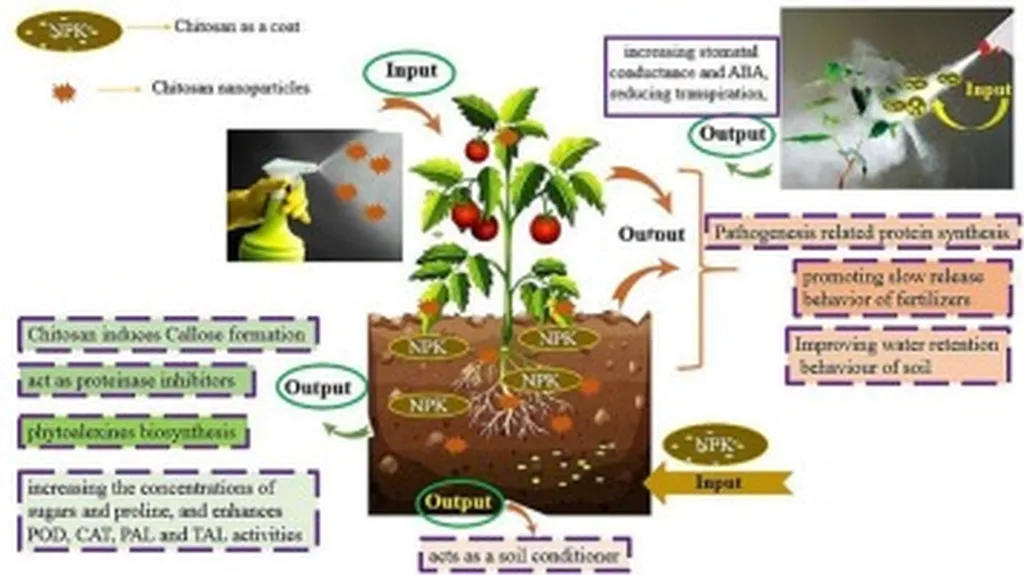In the quest for sustainable agriculture, researchers are increasingly turning to eco-friendly biostimulants to enhance crop production and nutritional value. A recent study published in *Caraka Tani: Journal of Sustainable Agriculture* has shed light on the promising effects of chitosan and folic acid on purslane (Portulaca oleracea L.), a nutrient-rich leafy vegetable prized for its medicinal and nutritional properties. The research, led by Thamena Farhan Kazem Sachet from the Agriculture College at Al-Qasim Green University in Babylon, offers insights that could reshape the way farmers approach crop enhancement.
Purslane, a hardy and fast-growing plant, is already a staple in many diets due to its high content of antioxidants, vitamins, and minerals. However, the study reveals that its potential can be significantly unlocked through the strategic application of chitosan and folic acid. Chitosan, derived from chitin, is a biopolymer known for its antimicrobial and plant growth-promoting properties. Folic acid, a B vitamin, plays a crucial role in plant metabolism and development.
The field experiment conducted by Sachet and her team employed a randomized complete block design, testing various concentrations of chitosan (0, 50, and 100 mg l⁻¹) and folic acid (0, 25, and 50 mg l⁻¹), both individually and in combination. The results were striking. The combined treatment of 100 mg l⁻¹ chitosan and 50 mg l⁻¹ folic acid yielded remarkable improvements in plant growth and leaf quality. Plant height increased by up to 30%, reaching 36.7 cm, while leaf area expanded to 17.8 cm², and the number of leaves per plant rose to 92. Fresh weight also saw a significant boost, reaching 91.2 g per plant, a 26% improvement over the control.
“These findings demonstrate the synergistic potential of chitosan and folic acid in enhancing purslane growth and quality,” said Sachet. “The combined application not only improved plant biomass but also significantly increased the concentration of essential nutrients and antioxidant compounds.”
The study’s results extend beyond mere growth metrics. Leaf quality saw substantial enhancements, with total chlorophyll and carotenoid levels rising by 13% and 10%, respectively. Antioxidant levels were also markedly improved, with phenols, flavonoids, tannins, saponins, and ascorbic acid all showing significant increases. The DPPH radical scavenging activity, a measure of antioxidant capacity, reached 77.32%, a 54% increase over the control and higher than single applications of either chitosan or folic acid.
The commercial implications of these findings are profound. As consumer demand for nutrient-rich, sustainably grown produce continues to rise, farmers and agribusinesses are increasingly seeking eco-friendly solutions to enhance crop yield and quality. Chitosan and folic acid, both relatively low-cost and readily available, offer a promising alternative to synthetic fertilizers and pesticides. Their application could not only improve the nutritional profile of purslane but also enhance its market value, providing farmers with a competitive edge.
“This research opens up new avenues for sustainable agriculture,” said Sachet. “By leveraging the synergistic effects of chitosan and folic acid, we can enhance crop production while minimizing environmental impact.”
The study’s findings are particularly relevant in the context of global efforts to promote sustainable agriculture. As the world grapples with the challenges of climate change, soil degradation, and water scarcity, the need for innovative, eco-friendly solutions has never been greater. The use of biostimulants like chitosan and folic acid represents a step towards a more sustainable future, one where crop enhancement and environmental stewardship go hand in hand.
Looking ahead, the research conducted by Sachet and her team could pave the way for further exploration into the use of biostimulants in agriculture. Future studies might delve deeper into the mechanisms underlying the synergistic effects of chitosan and folic acid, as well as their potential applications in other crops. Additionally, the commercialization of these findings could lead to the development of new agricultural products and practices, further enhancing the sustainability and profitability of farming.
In conclusion, the study published in *Caraka Tani: Journal of Sustainable Agriculture* offers a compelling case for the use of chitosan and folic acid as biostimulants in purslane cultivation. The findings not only highlight the potential of these compounds to enhance crop growth and quality but also underscore the broader implications for sustainable agriculture. As the world continues to seek innovative solutions to the challenges of modern farming, the insights provided by this research could prove invaluable in shaping the future of the agriculture sector.

